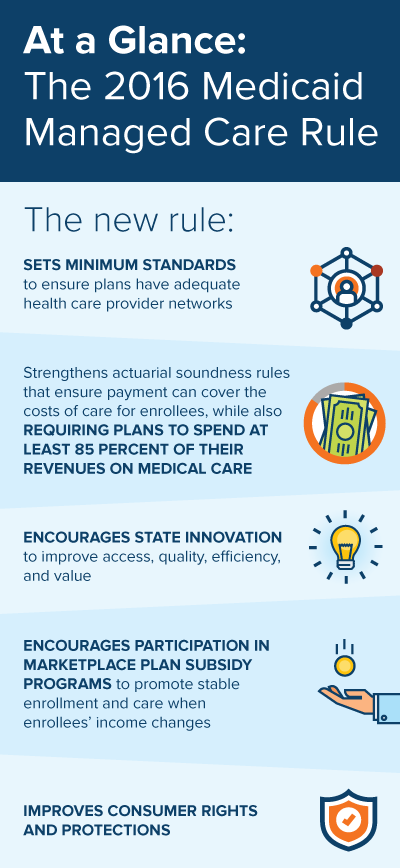The Centers for Medicare and Medicaid Services last week introduced a final Medicaid managed care rule establishing a new regulatory framework for the next generation of managed care. A policy watershed, the rule ultimately will touch the lives of tens of millions of low-income children and adults, and individuals with disabilities. Estimates suggest that a majority of today’s 72 million Medicaid beneficiaries are enrolled in managed care plans in 40 states (including the District of Columbia), and the number is expected to increase over the next decade.
The rule places states in the driver’s seat of an undertaking that is not for the faint of heart. As explained in a still-relevant 1997 landmark study, states have been working toward creating entire health care delivery systems for their Medicaid managed care beneficiaries. As they tackle everything from marketing and enrollment to quality improvement in service delivery and creating relationships with social service programs, states face unique challenges because of whom they serve and the level of coverage and service integration that managed care must be structured to achieve.

While the Affordable Care Act (ACA) fundamentally reformed the health insurance policy landscape, state Medicaid programs still carry a heavy burden since the Medicaid population is poorer and faces high health risks.
As a result, certain challenges endure:
1. Reaching medically underserved communities. The final rule adds teeth to the prior health care provider network-adequacy standard. Yet Medicaid beneficiaries are more likely to live in medically underserved communities that frequently lack the providers essential to building quality networks. Safety-net providers such as community health centers and public and mission-driven hospital systems form the Medicaid managed care provider network backbone, but they, too, experience staff shortages. One recent study reported that simply by filling open positions, health centers could serve 2 million more patients.
2. Unstable eligibility and enrollment. The ACA represented a turning point in coverage opportunities for low-income Americans. Yet eligibility for both Medicaid and the tax subsidies offered through the ACA’s insurance marketplaces is closely tied to family income. Even with the massive efforts now under way to streamline enrollment and renewal, nothing can overcome the income fluctuations that can cause coverage shifts over time. The risk of breaks in coverage remains, especially in states that have chosen not to expand Medicaid eligibility. Therefore the rule’s emphasis on making it possible for health plans to participate in both the Medicaid managed care market and the qualified health plan marketplace, so that people can remain enrolled in their plans, represents a key opportunity for states. (Today, about four of 10 insurance companies participate in both Medicaid and the ACA marketplaces.)
3. Organizing coverage and care and developing effective payment incentives. The final rule stresses value-based purchasing as a core Medicaid managed care policy aim. But designing Medicaid contracts poses a mammoth challenge that really has no equivalent in the private insurance market. In private insurance, coverage equals what benefits are listed in the policy (e.g., speech therapy). In Medicaid, by contrast, coverage can extend beyond the health plans’ contracts. For example, a state could include up to 10 speech therapy visits in its contracts, while leaving the far-higher level of speech therapy needed by certain children with developmental disabilities in Medicaid’s fee-for-service program. Deciding what to include in a plan contract and what to carve out into separate specialized plans or leave in the fee-for-service system carries major downstream implications for plans’ network needs, utilization management activities, and use of financial incentives to promote quality and efficiency.
4. Aligning managed care with health, education, nutrition, and social services. With the exception of long-term services and support plans, the final rule does not directly address developing partnerships between managed care plans and social, educational, housing, and economic security programs. Nor does it consider efforts by nonprofit hospitals that are part of managed care networks and that choose to devote a portion of community benefit spending to population health interventions to reduce smoking or obesity, for example. But achieving greater integration in health and health care is emerging as a key priority among states, and the rule permits states to continue to move in this direction by developing managed care systems that can bridge health and social services.
5. Information technology. The final rule’s emphasis on information underscores that successful managed care turns on the use and exchange of information. But information technology remains a fundamental challenge, particularly for long-term services and supports. Despite a $30 billion federal investment, health systems today remain woefully underfunded, particularly those needed to support long-term care plans, since the HITECH Act created incentives only for hospitals and clinical practices.
Despite these challenges, states continue to drive forward, as they must. The ACA’s insurance reforms opened the door to a far more effective Medicaid managed care system, and with this rule in place, the real work begins.



